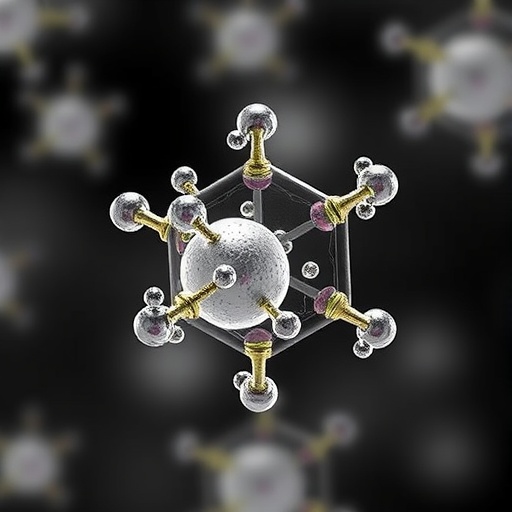Recent advancements in nanotechnology have ushered in a new era of materials with unique properties, particularly in the realm of energy storage and electronic devices. One such remarkable innovation is the development of biphasic cerium oxide nanoparticles, which have emerged as a dual-functional material in dielectric and supercapacitor applications. This breakthrough, explored by Prakash et al., reveals the immense potential for cerium oxide nanoparticles to transform current technologies, offering enhancements that could significantly benefit both industrial and consumer applications.
Cerium oxide, a versatile material known for its oxygen storage capacity and redox behavior, has garnered attention in various fields. Its nanoparticles, due to their high surface area to volume ratio, exhibit enhanced properties that are critical for advanced applications. The research conducted by Prakash and colleagues emphasizes not only the structural and functional versatility of these nanoparticles but also their dual-role capabilities that can cater to a wide array of uses. This synergistic functionality places cerium oxide nanoparticles at the forefront of innovations designed to tackle the escalating demand for efficient energy solutions.
The study meticulously outlines the synthetic strategies employed to produce biphasic cerium oxide nanoparticles. The researchers utilized a hydrothermal method for the synthesis process, which allows for precise control over the particle size and morphology. By adjusting various synthesis parameters, they achieved nanoparticles that exhibit both fluorite and monoclinic structures. This unique combination of phases is pivotal as it enhances the electronic properties required for optimal performance in energy storage systems.
Characterization techniques such as X-ray diffraction (XRD) and transmission electron microscopy (TEM) were employed extensively to analyze the synthesized nanoparticles. XRD results confirmed the presence of both crystalline phases, while TEM visualization provided clear images demonstrating the nanoparticles’ uniformity and size control. These techniques not only validate the synthesis protocol but also illustrate the promising characteristics of the material that could lead to substantial improvements in energy density and conductivity.
One of the compelling attributes of biphasic cerium oxide nanoparticles is their dielectric properties. Dielectrics play a crucial role in electronic devices, influencing their performance capabilities, including energy storage and signal transmission. The biphasic nature of cerium oxide facilitates improved dielectric constant and loss tangent values, rendering them highly suitable for various applications in capacitors and other electronic components. This enhancement is significant for next-generation devices that demand higher efficiency and smaller form factors.
Moreover, the study delves into the supercapacitor applications of cerium oxide nanoparticles. Supercapacitors are recognized for their ability to deliver quick bursts of energy, primarily in applications requiring rapid charge and discharge cycles. The incorporation of biphasic cerium oxide nanoparticles in supercapacitor design has shown promising results, enhancing capacitance values while maintaining excellent cycle stability. This aspect makes them a formidable candidate for energy storage solutions in electric vehicles and renewable energy systems.
An intriguing aspect of the research pertains to the environmental sustainability associated with using cerium oxide nanoparticles. As industries increasingly emphasize eco-friendly materials, the synthesis and application of cerium oxide also aligns with green chemistry principles. The incorporation of lightweight, non-toxic materials could result in safer products and diminish the ecological footprint usually associated with traditional capacitor technologies.
The findings of Prakash et al. contribute significantly to existing literature, providing a comprehensive understanding of how biphasic cerium oxide nanoparticles function. By elucidating their mechanisms and potential applications through rigorous experimental protocols, the research prepares the groundwork for future studies. Such foundational work is essential for industrial researchers and engineers who aim to innovate further in the field of energy storage and electronic devices.
In the ever-evolving landscape of technology, the ability to tailor materials at the nanoscale offers immense opportunities for innovation. The biphasic cerium oxide nanoparticles unveiled in this research are a testament to how nanotechnology can lead to significant breakthroughs. With continued research and development, we may witness these materials being integrated into everyday products, enhancing their functionality and performance metrics.
The study also opens avenues for interdisciplinary collaboration, as engineers, chemists, and material scientists explore the depths of this emerging field. As researchers build on the findings documented by Prakash et al., it is plausible that we will see enhancements in not only energy storage devices but also in sensors, actuators, and potentially even catalysts in various chemical processes.
To conclude, the exploration of biphasic cerium oxide nanoparticles as presented by Prakash and colleagues sets the stage for a future where energy storage and electronic devices are revolutionized. With their dual functionality and superior performance characteristics, these nanoparticles embody the promise of a more efficient, sustainable, and technologically advanced future. As the scientific community investigates further, the potential applications of these nanoparticles could reshape numerous sectors, emphasizing the fusion of innovation and sustainability in material science.
Subject of Research: Biphasic cerium oxide nanoparticles for dielectric and supercapacitor applications.
Article Title: Biphasic cerium oxide nanoparticles: a dual-functional approach for dielectric and supercapacitor applications.
Article References:
Prakash, O., Verma, K.D., Upadhyay, L. et al. Biphasic cerium oxide nanoparticles: a dual-functional approach for dielectric and supercapacitor applications.
Ionics (2025). https://doi.org/10.1007/s11581-025-06643-0
Image Credits: AI Generated
DOI: https://doi.org/10.1007/s11581-025-06643-0
Keywords: Biphasic cerium oxide, nanoparticles, dielectric applications, supercapacitors, energy storage, nanotechnology.




